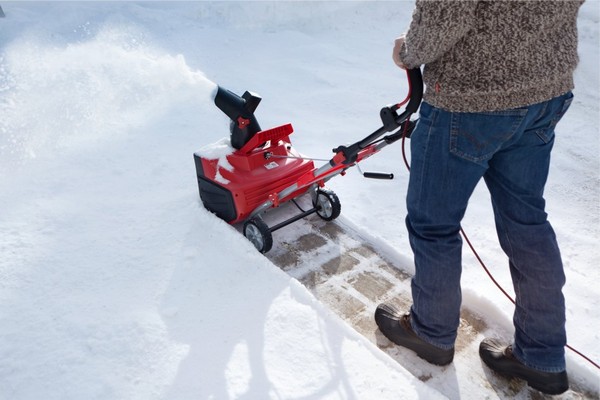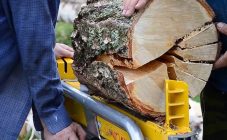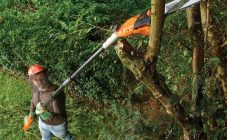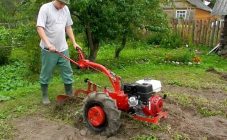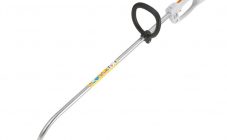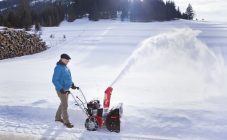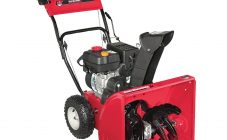Content:
An electric snow blower is ideal for daily snow removal in a small cottage, around a home, office or shop. It is easy to operate, does not require special physical strength, so even a teenager can use it. The snow blower is suitable for clearing the area from freshly fallen snow.
Electric snow blower device
A snow blower is a bucket with wheels designed to crush snow and throw it to the side through the nozzle. Inside the bucket there are spiral augers that work like a meat grinder.
Main structural elements:
- electric motor with power from 2 to 3 kW;
- snow cleaning system can be auger (with a plastic, metal or rubberized auger) or rotary.
- the gearbox consists of 2-4 bronze or brass gears in a housing made of aluminum, plastic;
- snow receiver made of metal or impact-resistant plastic;
- plastic case;
- a chute that can be turned in the required direction using a handle;
- the control panel is represented by a group of devices for adjusting the range of snow throwing, clutch and other functions;
- battery up to 200 watts with charger (for rechargeable models).
Depending on the type of drive, the snow blower is:
- Non-self-propelled (single-stage) removes snow by rotating the auger;
- Self-propelled (two-stage) removes packed snow, ice, thanks to the auger and rotor. Can be on wheels or tracks.
Main settings
Electric snow removal equipment is designed to serve a small area, with an area of about 100 m2 to 250 m2.
Main technical characteristics:
- Power is 1-2 kW, more powerful models should be preferred for clearing packed snow.
- The coverage area of the site depends on the size of the bucket - from 25 to 60 cm.
- Snow capture depth - from 10 to 30 cm.
- Snow discharge - from 1 to 16 m.
- Unit weight ranges from 5 to 25 kg.
The track width to be cleared is influenced by the model type, engine power, snow throwing distance, and the presence of a rotor. A low-power motor allows you to clear a track half a meter wide, ejects snow by 2-3 m.
The best result can be obtained with the installed second cleaning stage - the rotor.
This model is also used to deal with ice and caked snow. In this case, you should not use a model with a plastic auger, as it wears out quickly from overloads. Electric snow blowers with metal augers and rubber-coated plastic augers cope with this task.
Comparison with other snow blowers
In terms of parameters and purpose, an electric snow blower takes the middle position between mechanical shovels and gasoline snow blowers. The former are characterized by low performance, low cost and lightness. The gasoline unit is superior to the electric one in performance, weight, cost. An electric snow thrower is cheaper than a gasoline thrower and more efficient than a mechanical shovel.
The main advantages of an electric snow blower over a gasoline one:
- The electric model is lighter, so it can be used on steps and wooden terraces, in hard-to-reach places.
- No oil change or refueling service required. All you need is electricity and an extension cord, which makes the electrical unit more economical.
- Lower cost compared to a gasoline unit.
- The electrical unit is compact and easy to store.
- Self-propelled and mobility.
- Lightness and noiselessness. A heavier petrol powered snow blower produces 2 or 3 times the noise.
Disadvantages:
- The power of the electric model (2.7 horsepower) is lower than the gasoline model (3 to 15 horsepower).
- The electric model of the snow blower is inferior to the gasoline model in terms of the depth of the removed snow. The gasoline unit is able to cope with a snow mass with a height of about 45 cm, while the electric one is no more than 28 cm. The design features of the bucket of the gasoline unit also cope with greater depth when raising the front of the machine.
- The need for an extension cord, dependence on access to electricity.
Additional functions
Manufacturers of some models complement the snow blowers with useful functions:
- headlamp for evening cleaning in the dark;
- heated handles, which is important in winter;
- foldable handle for more compact storage;
- system of blocking the electric motor and auger when releasing the control levers.
Work restrictions
The main problems with the operation of the snow blower can be associated with the outlet or the cable. With a power of 2 kW, a current of 9 amperes is required, for 3 kW - 13.5 amperes. Old sockets can easily fail from overheating, since not the entire network of a country house can perceive such power. Short circuit and fire possible. Therefore, the owner of the cottage should check or replace the outlet before starting work.
The length of the cable is limited to 30-50 m. A longer cable will become tangled and may get caught under the rotor.
The cable must be frost-resistant, rubber, with a moisture-resistant socket. To avoid tangling, wind it around a rotating drum. After removing the snow, the cable is reeled up by hand.
Top Models
Several popular electric snow blowers have the best performance:
- AL-KO SnowLine 46E;
- PATRIOT PS 2200 E;
- Champion STE1650;
- Huter SGC 2000E;
- Toro 38302;
- DAEWOO DAST 3000E.
Each of the models has its own advantages and disadvantages. Snow blowers are produced by companies such as Caliber, Huter, daewoo, CROSSER, hyundai, PATRIOT GARDEN, PRORAB, Aiken, Sun Garden, SNBE. Craftsmen assemble an electric snow blower at home according to a drawing.
When working with an electric snow blower, you should wear a closed uniform, shoes. Eyes must be goggles. Repair and replacement of parts should only be carried out after disconnecting the unit from the mains.
